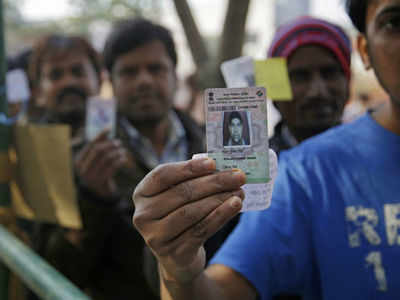- News
- Elections News
- Assembly Elections News
- Uttar Pradesh News
- Second phase of UP polls: Well-off yet poor on health & education
This story is from February 13, 2017
Second phase of UP polls: Well-off yet poor on health & education

UP’s election thriller turns north by northwest for the second phase of polling on February 15, covering an 11-district belt — most of it known as Rohilkhand — emblematic of the state’s diversity.
From bamboo flute capital Pilibhit and the brass capital Moradabad to an erstwhile capital of the medieval Delhi Sultanate, Badaun and UP’s only national park, the Dudhwa in Lakhimpur Kheri, this region has the state’s highest concentration of minorities at 36%.In five districts Muslim population is over 40%. This includes Rampur with over 50% Muslim residents.
There is a Sikh diaspora as well numbering some 50,000 in the terai districts, who settled in the swamps and started farming after DDT eradicated malaria in the 1960s. Kheri also has the only enclave of Tharu tribals in the Dudhwa forest ranges.
Although farming is the major occupation, Saharanpur with its paper, tobacco and woodwork factories, Kheri with its sugar mills and Bareilly with its agro-based units provide an industrial spine to the area.
Within the region, there is notable differences among the districts — some are richer, others poorer. Once famous for its ‘Rampuri kinves’, Rampur district’s per capita income is almost 50% less than that of Bareilly, the front runner.
Moradabad’s export dependent brass industry is now in doldrums due to a listless global market and has dragged it down nearly to the level of Lakhimpur Kheri a largely agricultural district with only sugarcane and sugar manufacture as its main source of income.
Incidentally Kheri is the largest assembly constituency in UP. Saharanpur, another industrial city is much more prosperous and second only to Bareilly.
The area once had a relatively advanced educational system because of the colleges in Bareilly and to an extent Rampur, famous for its Raza Library.
But over the years, districts like Shahjahanpur, Pilibhit, Kheri, Budaun have got left behind. The region as a whole has just 6 colleges per lakh population, compared to the neighbouring west UP region that has 16. Health of the people in the region is starkly threatened as shown by some key indicators.
Kheri, Shahjahanpur, Bareilly, Saharanpur and Budaun districts have infant mortality rates of about 80 deaths per 1000 live births, compared to the state average of 68, and under-5 mortality rates of over 100 compared to UP’s 90. Budaun and Shaahanpur figure in the country’s top 20 districts in terms of average number of children born. This along with the low women’s literacy rates shows the patriarchal stranglehold.
From bamboo flute capital Pilibhit and the brass capital Moradabad to an erstwhile capital of the medieval Delhi Sultanate, Badaun and UP’s only national park, the Dudhwa in Lakhimpur Kheri, this region has the state’s highest concentration of minorities at 36%.In five districts Muslim population is over 40%. This includes Rampur with over 50% Muslim residents.
There is a Sikh diaspora as well numbering some 50,000 in the terai districts, who settled in the swamps and started farming after DDT eradicated malaria in the 1960s. Kheri also has the only enclave of Tharu tribals in the Dudhwa forest ranges.
Although farming is the major occupation, Saharanpur with its paper, tobacco and woodwork factories, Kheri with its sugar mills and Bareilly with its agro-based units provide an industrial spine to the area.
The land is criss-crossed by numerous rivers that feed the Ganga flowing through some of this belt’s districts. With ample water resources, and a strong canal system, almost all the cultivated land is irrigated. As a result, power consumption is 230 kwh, lower than the State average of 300 kwh. Wheat, rice, sugarcane and vegetables are grown extensively, as are mangoes.
Within the region, there is notable differences among the districts — some are richer, others poorer. Once famous for its ‘Rampuri kinves’, Rampur district’s per capita income is almost 50% less than that of Bareilly, the front runner.
Moradabad’s export dependent brass industry is now in doldrums due to a listless global market and has dragged it down nearly to the level of Lakhimpur Kheri a largely agricultural district with only sugarcane and sugar manufacture as its main source of income.
Incidentally Kheri is the largest assembly constituency in UP. Saharanpur, another industrial city is much more prosperous and second only to Bareilly.
The area once had a relatively advanced educational system because of the colleges in Bareilly and to an extent Rampur, famous for its Raza Library.
But over the years, districts like Shahjahanpur, Pilibhit, Kheri, Budaun have got left behind. The region as a whole has just 6 colleges per lakh population, compared to the neighbouring west UP region that has 16. Health of the people in the region is starkly threatened as shown by some key indicators.
Kheri, Shahjahanpur, Bareilly, Saharanpur and Budaun districts have infant mortality rates of about 80 deaths per 1000 live births, compared to the state average of 68, and under-5 mortality rates of over 100 compared to UP’s 90. Budaun and Shaahanpur figure in the country’s top 20 districts in terms of average number of children born. This along with the low women’s literacy rates shows the patriarchal stranglehold.
End of Article
FOLLOW US ON SOCIAL MEDIA
